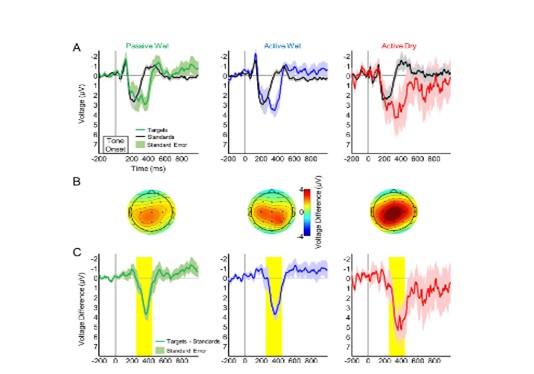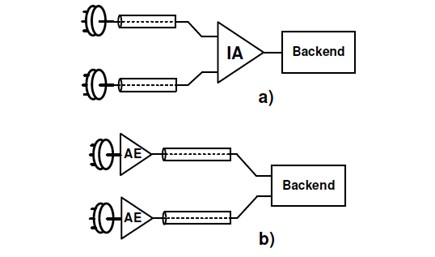When the British physician Richard Caton first recorded the brain’s electrical activity on a rabbit in the late 19th century he didn’t know his groundbreaking experiment would inspire the invention of a line of revolutionary technologies that turned out to be indispensable assets of neuroscience. One of those inventions is Hans Berger’s electroencephalography (EEG), which transformed the diagnosis of neurological conditions. Since then EEG has gone through several advancements, of which a key one is active EEG electrodes.
Because every innovation comes with certain pluses and minuses, it is of primary importance to clarify them for users. The guiding principle of any EEG innovation is to improve the quality of signals recorded from the brain while balancing usability and user comfort. Only after fully understanding these pros and cons could one make the right choices for their use case be it clinical, research, or other.
What are Active and Passive Electrodes?
The brain’s electrical activity (brain potential) is a sum of the myriad discharges generated from neuronal action potentials. Although a single action potential is detectable in the millivolt (mV) range, the combined effect of a large population of neurons on the voltage of the brain tissue relative to a neutral point is the sum of all action potentials. Because of the inherent stochasticity of these action potentials, the simultaneous positive and negative fluctuations cancel each other. Therefore, the net voltage fluctuation in the brain tissue is a fraction of that of the neuron, yielding to a fluctuation in the microvolt (uV) range. Fortunately, neurons often act in concert to achieve effective control of target tissues. When they do so, the millions of action potentials synchronize in oscillatory patterns like flocking birds synchronize their flying. Those oscillations form traveling waves over the surface of the cerebral cortex penetrating the skull and yielding to discernable voltage fluctuation over the scalp, a signal known as EEG.
To noninvasively capture the brain’s electric potential fluctuations over the skull, two different EEG electrode technology options are available. One is passive electrodes and the other is active electrode technology. Passive electrodes are traditional EEG electrodes that simply transmit the voltage fluctuation to the amplifier through a conductive wire. To attain a low-impedance contact we use Silver-Silver Chloride (Ag/AgCl), or gold electrodes. However, the need for skin preparation to achieve a low enough impedance (under 10Kohm), the cost of the electrodes (~$10/electrode), the labor-intensive gluing method, the inconvenience to the patient, and most importantly the increasing cases of skin breakdown encouraged innovation in EEG electrode technology. A well glued gold-cup EEG electrode on a clean exposed skin surface with an adequate amount of electrode paste on a relaxed motionless subject in an electromagnetically shielded room, with the amplifier a few feet (1-2 m) distance from the subject, can provide a relatively clean EEG, that shows discernible delta, theta, alpha, beta oscillations in the EEG. These oscillations originate from the brain, hence passive electrode technology was for a while the ultimate low-cost, noninvasive brain activity monitoring modality for extensive clinical and research purposes.
Active electrode technology was developed partly in response to not needing skin preparation. The second factor was to prevent the weak EEG signal from being contaminated by noise while traveling through the long wire. The solution to handle both was moving a part of the amplifier as close as possible to the electrode thereby buffering the signal close to the scalp (Fig. 1). Because in the case of active electrode implementation the cables carry a signal driven strongly by the pre-amplifier which makes it less susceptible to electromagnetic interference thereby improving the signal to noise ratio. A high input impedance pre-amplifier also mitigates the need for abrading skin or using conductive paste in order to drop skin impedance.
Figure 1. The graphical scheme of conventional EEG with an instrumentation amplifier before the backend (a) versus the active electrode solution where the amplifiers are placed proximal to the electrodes (From Xu et al., 2017).
The Active electrode has two components, the electrode, and the preamplifier circuit. The electrode materials need to be carefully chosen so as to not have polarization effects and are typically silver/silver chloride (Ag-AgCl). The performance of such a dry-active electrode array was first demonstrated at the University of California, Davis, by Babak Taheri in the 1990s.
Passive electrodes, in contrast, are generally plated with Ag-AgCl or gold and need electrolytic paste or gel (they are frequently called wet electrodes for this reason). However, the scalp is first prepared to minimize electrode-scalp impedance which is recommended to be under 10Kohm.
A report of the construction, performance, and results of the first dry-active electrode appeared in a 1994 scientific publication. One of the initial observations made was the fact that the arrayed active electrodes outperformed the passive electrodes.
To understand how active electrodes could achieve such a good performance we need to compare the underlying signal transmissions implemented by these two types of EEG electrodes.
Pros And Cons of Active and Passive EEG Electrodes
Active and Passive Electrodes Pros
Active electrodes allow pre-amplification modules close to the electrode. Hence, these EEG electrodes enable signal amplification before any extra noise attacks the EEG signal.
Active electrodes can make a big difference in a multitude of scenarios. First and most important, they enable the use of dry electrodes. Dry electrodes, in general, are associated with higher noise levels because they are not glued to the skin surface nor do they use a conductive gel that creates a low impedance bridge between the skin and the EEG electrodes.
Likewise, active electrodes do great when the measurement occurs in areas with fair amounts of electromagnetic noise and when there will be a considerable distance between the system and the electrodes used for EEG.
For passive electrodes, a conductive gel is a must to minimize impedance, so as to enable the signal to travel reliably through the wire. Moreover, during extended usage of wet passive electrodes, the gel may dry up leading to poor quality of the recording.
Active and Passive Electrodes Cons
On the other hand, passive electrodes are simpler to manufacture, and they cost and weigh less as they lack the pre-amplification modules that active electrodes have. Active electrodes also require more wires (additional power and ground) to enable the functioning of the pre-amplifier. Passive electrodes can achieve very good performance when the electrode has a stable low impedance.
Comparing Active and Passive EEG Electrodes in Amplification System Test
A growing number of studies demonstrated a superior signal quality of active electrodes over passive electrodes. When the active electrode technology is applied to dry electrodes, it can compensate for the higher impedance of the dry electrodes and achieve equivalence with the gel-loaded passive electrodes with all the benefits deriving from the active electrodes.
The illustration below was taken from a study involving 8 participants after recording EEG reading following the emission of auditory stimuli.

The reading produced by the active electrodes was instantaneous in response to the Event-Related Potentials (ERPs) recorded after the emission of the auditory stimulus. Furthermore, there was a significantly reduced error in the voltage difference between the EEG electrodes’ recorded measurement and the reference signal.
Another study compared the active and passive electrodes in an ERP during cognitive tasks (Laszlo et al., 2014). The study involved two experiments. In the first experiment, researchers manipulated interelectrode impedance in an electrically quiet setting to check if active electrodes produced better results under such recording conditions. In the second experiment, they studied active electrodes’ ability to record when limited by natural skin impedance. The investigation also explored the relationship between voltage stability and active amplification circuitry in EOG. Results from both experiments showed complicated connections between voltage stability, electrode types, and impedance. Ultimately, the study indicated that active electrodes outperformed passive electrodes at different impedance levels except for very low ones. To be specific, passive electrodes obtained higher quality data only when impedance was less than 2 kΩ. That said, it’s worth noting that passive ones also were better at accurately following the EEG than active ones in the event of rapid voltage fluctuations.
Conclusion
The quality of EEG recordings depends on several factors. Whether you prefer to use an active electrode EEG system or not, it is vital to know the pluses and minuses. Active electrode technology when used with high-quality electrodes (e.g., gold-plated) with conductive paste provides the best of both worlds, i.e., low skin impedance and a well-driven signal that is less susceptible to noise. However, in such cases when these electrode wires need to be disposed of due to wear and tear along with the pre-amplifier assembly, the cost could become prohibitively expensive. Hence active electrodes most commonly enable the use of dry electrode EEG systems, which allows you to reuse the EEG cap and dispose of just the electrodes. Such wireless EEG systems also enable the fast and easy setup of EEG without elaborate prep work. Signal quality in such cases has shown to be as good or in some cases better than just conventional passive electrodes. In summary, active electrode technology always makes the EEG signal quality better. They cost more because of the additional circuitry and wires needed. If disposed of with the electrode wires, they could be too expensive; however, if reused with a cap-like system, the cost is not a concern. With costs dropping fast for such commodity parts, there is adequate reason to believe active electrodes will replace passive ones in the next few years.
REFERENCES:
1) Xu J, Mitra S, Van Hoof C, Yazicioglu RF, Makinwa KAA. Active Electrodes for Wearable EEG Acquisition: Review and Electronics Design Methodology. IEEE Reviews in Biomedical Engineering. 2017 ;10:187-198. DOI: 10.1109/rbme.2017.2656388.
2) Kelly, J. W., Siewiorek, D. P., Smailagic, A., & Wang, W. (2013). Automated filtering of common-mode artifacts in multichannel physiological recordings. IEEE transactions on bio-medical engineering, 60(10), 2760-2770. https://doi.org/10.1109/TBME.2013.2264722
3) Laszlo S, Ruiz-Blondet M, Khalifian N, Chu F, Jin Z, A direct comparison of active and passive amplification electrodes in the same amplifier system, Journal of Neuroscience Methods, 2014, Volume 235, 298-307, https://doi.org/10.1016/j.jneumeth.2014.05.012.


